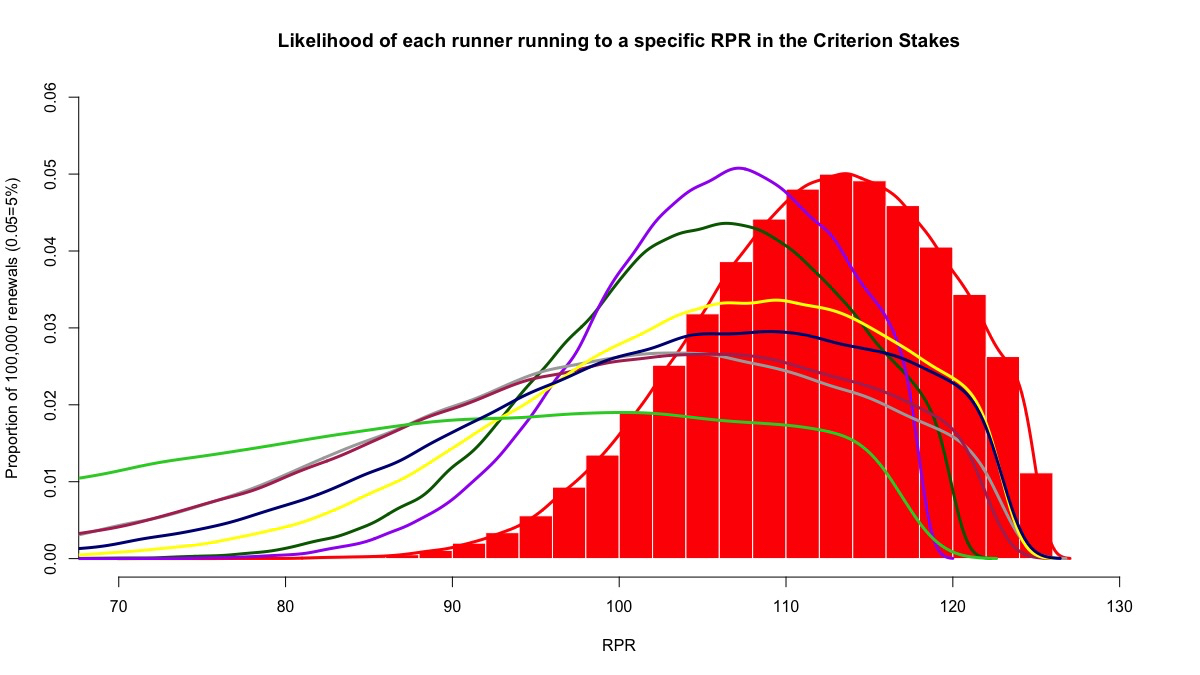Over Royal Ascot I simulated 100,000 renewals of the Queen Anne, Prince Of Wales’s Stakes and Hardwicke Stakes by using recent (2018 on) RPR data from the runners as a means of predicting how likely each horse was to achieve a certain RPR (and win, or place, in each simulation). The main goal of doing that was of course to pinpoint some value.
The early signs were promising. My model suggested Crystal Ocean was by far and away the likeliest winner of the Prince Of Wales’s Stakes and that Mirage Dancer (third) was a great value bet in the place marker of the Hardwicke, as well as indicating that the first two in the Queen Anne had much better chances than the bookmakers thought. It additionally pinpointed a couple of shorter-priced fancies that looked under-priced (and which duly failed to make the frame).
Here I provide results for the Criterion Stakes at Newmarket after following the same method. This is a relatively good race to perform these simulations on, given that most of the runners have a comprehensive back-history of running in Graded/Group/Listed company and a lot of RPR data to work with.
Data and Method
I used exactly the same base method as described previously (see the Queen Anne post for more detailed information). More briefly, I:
- Recorded the RPR average (mean) and standard deviation (a measure of the variation around the mean) of all horses from turf Group/Graded/Listed races in 2018 and 2019
- Computed 100,000 potential RPRs for each horse by using the analysis software, R, and a “truncated” normal distribution algorithm (with the lower limits set at a possible RPR of 0 and the upper at 3lb above seven of the eight horses’ highest recent RPR, and 5lb above the other one [Glorious Journey], because he is significantly less exposed and has had far fewer starts than the others, and is thus more likely to be capable of a significant improvement on past RPRs) — see figure below
Criterion Stakes — The likelihood of Suedois running to a specific RPR is shown by the red bars and curve, along with Limato (dark green), Breton Rock (purple), Cardsharp (grey), Glorious Journey (maroon), Larchmont Lad (yellow), Salateen (light green), and Tabarrak (blue).
- Ranked horses from highest RPR to lowest in each of the 100,000 simulated renewals and then calculate the proportion of these that each horse won (highest RPR) and placed in (highest three RPRs)
- Computed “fair” win and place odds for each horse based on these proportions
Results
According to the simulations Suedois should be outright favourite at around 3.0 (2-1) and very short in the place market (around 2-5) —see Table below.
|
Horse
|
Fair Win Odds |
Fair Place Odds |
| Limato | 11.8 | 2.67 |
| Breton Rock | 14.6 | 2.55 |
| Cardsharp | 10 | 3.5 |
| Glorious Journey | 10.5 | 3.4 |
| Larchmont Lad | 6.6 | 2.36 |
| Salateen | 45 | 7.5 |
| Suedois | 3 | 1.4 |
| Tabarrak | 6.9 | 2.6 |
There are a number of additional points of note. These include:
- Limato and Glorious Journey being a good bit bigger in the betting according to the simulations than with the bookmakers
- Larchmont Lad being a good bit shorter in the betting according to the simulations than he is with the bookmakers
- Each horse’s fair win odds correlate very closely with their fair place odds R2 = 0.91, or 91%); the semi-notable one that doesn’t correlate as closely as the rest is Breton Rock, whose place odds are relatively short in relation to his win odds. This is due to his consistency, with the model essentially predicting that a “typical” performance of his would be enough to hit the frame in roughly 40% of the simulations, but only enough to actually win around 7% of them.
Limitations
Any model is only as good as the data that is fed into it. While RPRs are a relatively solid way of assessing a horse’s ability based on past performances, they are not bombproof.
Additionally, the model does not weight recent runs (such as last-time-out) any differently to those included in the sample from last summer. In some cases, this may mean that recently out-of-form horses are given better chances of success than may be appropriate.
Advised bet(s) and staking plans
I am going to trial the simulation method from a punting point of view, tracking advised bets via a:
a) points-based staking plan (based on the perceived value available — see here for more info) beginning at a P&L of 0
b) conservative (1/4) Kelly Criterion statistic (see here for more info) beginning with a fictional bank of 1000 euro
For the Criterion, the bets will be:
a) 2 pts Place Suedois at 1.92 on Betfair Exchange as of 11:30 am, Saturday June 29
b) 108 euro Place Suedois (1/4 Kelly Criterion = 10.8% of bank)
Future Directions
I will be using this technique to produce “fair odds” for Hong Kong racing beginning next season. HK fare is appealing for this type of analysis as there is a huge amount of ultra-reliable data available to work with.
I plan to produce my own sectional-enhanced speed ratings for all horses running in HK and use these instead of RPRs to model “fair odds” ahead of many of the meetings.
Watch this space.


